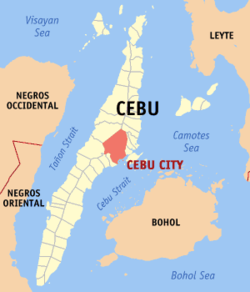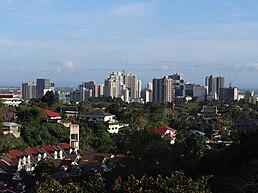This article or section may need to be rewritten to comply with Wikipedia's quality standards, as it uses Bisaya Patronymesis Sri Visjaya; Aginid, Bayok sa Atong Tawarik, and History of Panay from the first inhabitants and the Bornean immigrants from which the Bisayans are descended to the Arrival of the Spaniards as sources—all three have been proven hoaxes, as well as Macachor and Montebon's works, which greatly source from the former three. Needs to be properly researched as the page is possibly written with the intent of spreading propaganda. (November 2021) |
Cebu City
Dakbayan sa Sugbo | |
|---|---|
|
| |
Nicknames:
| |
| Anthem: Sugbuanon ako | |
 Map of Cebu with Cebu City highlighted | |
Location within the Philippines | |
| Coordinates: 10°17′35″N 123°54′07″E / 10.293°N 123.902°E | |
| Country | |
| Region | Central Visayas |
| Province | Cebu (geographically only) |
| District | 1st (North) and 2nd (South) districts of Cebu City |
| Founded (as Spanish colony) Reincorporated (as city) | 1565 24 February 1937 |
| Highly urbanized city | December 22, 1979 |
| Barangays | 80 (see Barangays) |
| Government | |
| • Type | Sangguniang Panlungsod |
| • Mayor | Raymond Alvin N. Garcia (PFP) |
| • Vice Mayor | Donaldo C. Hontiveros (Partido Barug) |
| • City Council | |
| • Congress | |
| • Electorate | 733,044 voters (2022) |
| Area | |
• City | 315.00 km2 (121.62 sq mi) |
| • Urban | 205 km2 (79 sq mi) |
| • Metro | 1,062.88 km2 (410.38 sq mi) |
| • Rank | 34th out of 145 |
| Elevation | 34 m (112 ft) |
| Highest elevation | 981 m (3,219 ft) |
| Lowest elevation | 0 m (0 ft) |
| Population (2020 census)[4] | |
• City | 964,169 |
| • Rank | 6th |
| • Density | 3,100/km2 (7,900/sq mi) |
| • Urban | 2,454,000[3] |
| • Metro | 3,164,337 |
| • Metro density | 3,000/km2 (7,700/sq mi) |
| • Households | 238,317 |
| Demonym | Cebuano |
| Economy | |
| • Gross domestic product (GDP) | ₱288.6 billion (2022)[5] $5.099 billion (2022)[6] |
| • Income class | 1st city income class |
| • Poverty incidence | 9.80 |
| • Revenue | ₱ 7,096 million (2020), 3,483 million (2012), 4,908 million (2013), 5,141 million (2014), 6,289 million (2015), 5,070 million (2016), 6.283 million (2017), 6,744 million (2018), 7,425 million (2019), 7,363 million (2021), 9,258 million (2022) |
| • Assets | ₱ 34,754 million (2020), 16,189 million (2012), 16,759 million (2013), 16,730 million (2014), 32,410 million (2015), 32,623 million (2016), 33,861 million (2017), 33,884 million (2018), 34,712 million (2019), 33,343 million (2021), 30,545 million (2022) |
| • Expenditure | ₱ 8,693 million (2020), 3,217 million (2012), 4,461 million (2013), 4,519 million (2014), 4,422 million (2015), 4,164 million (2016), 5,645 million (2017), 6,388 million (2018), 5,576 million (2019), 10,275 million (2021), 10,555 million (2022) |
| • Liabilities | ₱ 17,073 million (2020), 8,674 million (2012), 9,213 million (2013), 8,875 million (2014), 24,287 million (2015), 24,034 million (2016), 24,718 million (2017), 24,497 million (2018), 16,170 million (2019), 17,655 million (2021), 15,768 million (2022) |
| Service provider | |
| • Electricity | Visayan Electric Company (VECO) |
| Time zone | UTC+8 (PST) |
| ZIP code | 6000 |
| PSGC | |
| IDD : area code | +63 (0)32 |
| Sister cities | List |
| Catholic diocese | Archdiocese of Cebu |
| Website | cebucity |
Cebu City, officially the City of Cebu (Cebuano: Dakbayan sa Sugbo), is a 1st class highly urbanized city in the Central Visayas region of the Philippines. According to the 2020 census, it has a population of 964,169 people,[8] making it the sixth-most populated city in the nation and the most populous in the Visayas and in Central Visayas Region.
It serves as the capital of Cebu wherein it is geographically situated and grouped under the province by the Philippine Statistics Authority, but is one of three cities (together with Lapu-Lapu and Mandaue) that are administratively independent of the provincial government and also the largest city within that province. It also serves as the regional center of Central Visayas, and its metropolitan area exerts influence on commerce, trade, industry, education, culture, tourism, and healthcare beyond the region, over Central and Eastern Visayas and partly over Mindanao. It is the Philippines' main domestic shipping port and is home to about 80% of the country's domestic shipping companies. Additionally, Cebu City is the prime trading center of the southern Philippines.
Cebu City is bounded on the north by the town of Balamban and the city of Danao, on the west by the city of Toledo, on the east by the cities of Lapu-Lapu and Mandaue and the towns of Liloan, Consolacion and Compostela and to the south by the city of Talisay. Located at the center of the eastern seaboard of Cebu Island, it is the core city of Metro Cebu, the second largest metropolitan area in the Philippines, which includes the cities of Carcar, Danao, Lapu-Lapu, Mandaue, Naga and Talisay and the municipalities (towns) of Compostela, Consolacion, Cordova, Liloan, Minglanilla and San Fernando. Metro Cebu had a total population of 3,165,799 as of the 2020 census.[9]
The current political boundaries of the city are an incorporation of the former municipalities of Cebu, San Nicolas, El Pardo, Mabolo, Talamban and Banilad in the Commonwealth period.[10]
The city has experienced rapid economic growth since the 1990s, a phenomenon also known as "Ceboom". Owing to its economic importance and influence in modern times, Cebu City is also popularly referred to as the Queen City of the South.[11]
- ^ City of Cebu | (DILG)
- ^ "2015 Census of Population, Report No. 3 – Population, Land Area, and Population Density" (PDF). Philippine Statistics Authority. Quezon City, Philippines. August 2016. ISSN 0117-1453. Archived (PDF) from the original on May 25, 2021. Retrieved July 16, 2021.
- ^ a b c "Demographia World Urban Areas (17th Annual Edition, 2021.06)" (PDF). Demographia.com. Retrieved July 29, 2021.
- ^ "2020 Census of Population and Housing (2020 CPH) Population and Annual Growth Rates by Province, City, and Municipality - By Region". Metro Manila, Philippines: Philippine Statistics Authority. July 7, 2021. Retrieved July 8, 2021.
- ^ "All Provinces and HUCs in Northern Mindanao Continue to Expand in 2022; City of Cagayan de Oro Records the Fastest Growth with 9.4 Percent". Philippine Statistics Authority. Retrieved December 9, 2023.
- ^ "PH₱56.598 per dollar (per International Monetary Fund on Representative Exchange Rates for Selected Currencies for December 2022)". IMF. Retrieved December 9, 2023.
- ^ "PSA Releases the 2021 City and Municipal Level Poverty Estimates". Philippine Statistics Authority. April 2, 2024. Retrieved April 28, 2024.
- ^ Census of Population (2020). "Region VII (Central Visayas)". Total Population by Province, City, Municipality and Barangay. Philippine Statistics Authority. Retrieved July 8, 2021.
- ^ "Highlights of the Philippine Population 2015 Census of Population". Philippine Statistics Authority. May 19, 2016. Retrieved October 31, 2016.
- ^ Letigio, Delta Dyrecka (February 24, 2020). "The crowning of Cebu City, the Queen City of the South". CDN Digital. Retrieved August 17, 2020.
- ^ "A glimpse into Iloilo City's colorful past". August 22, 2011. Archived from the original on April 14, 2019. Retrieved March 25, 2023.













